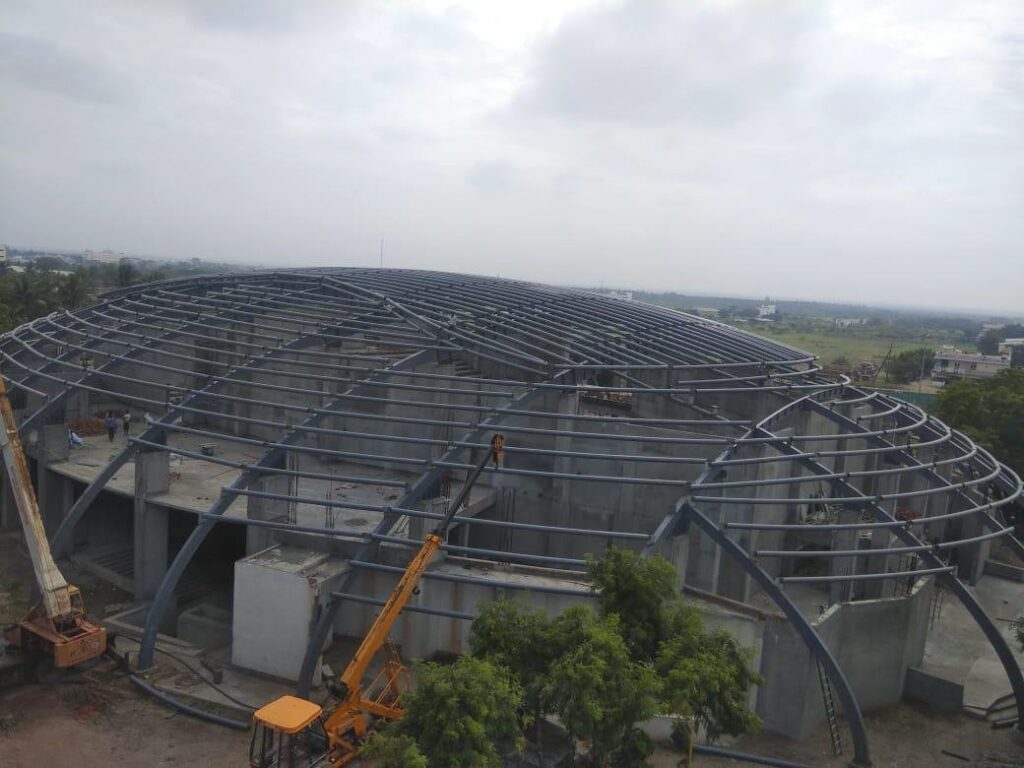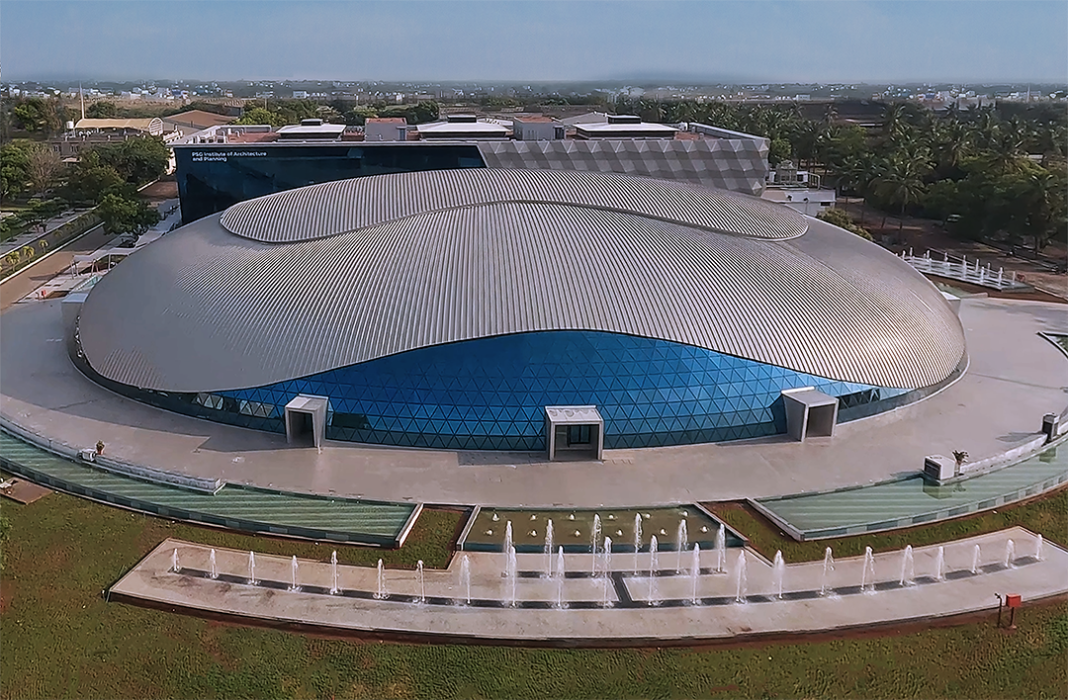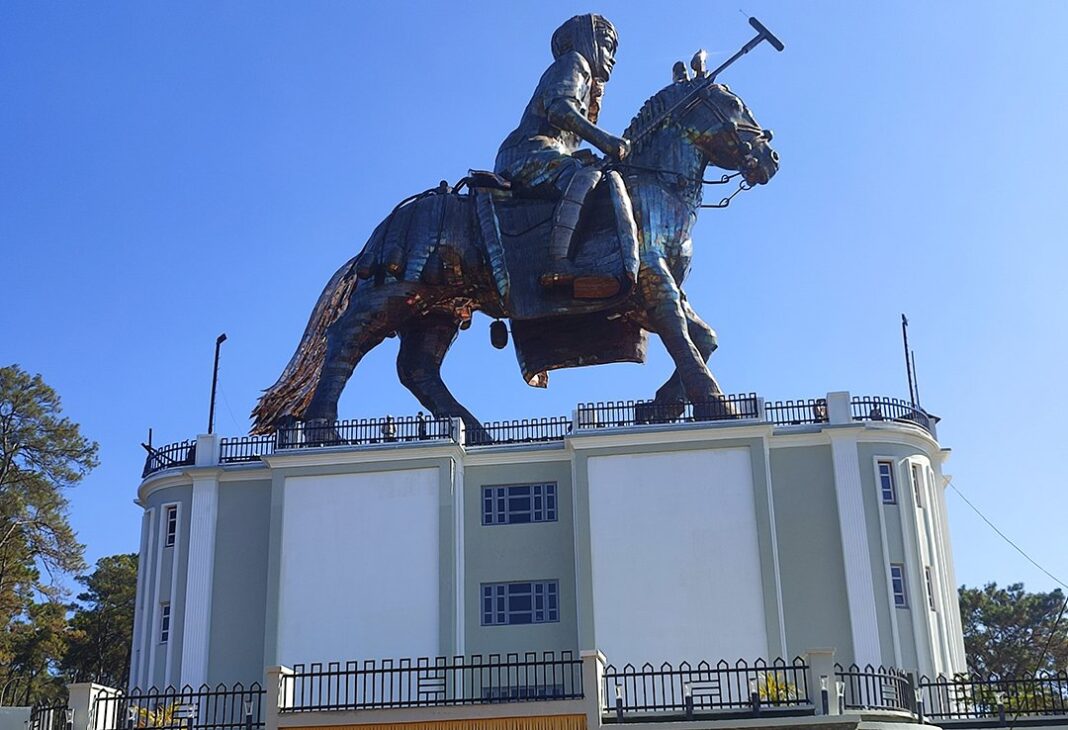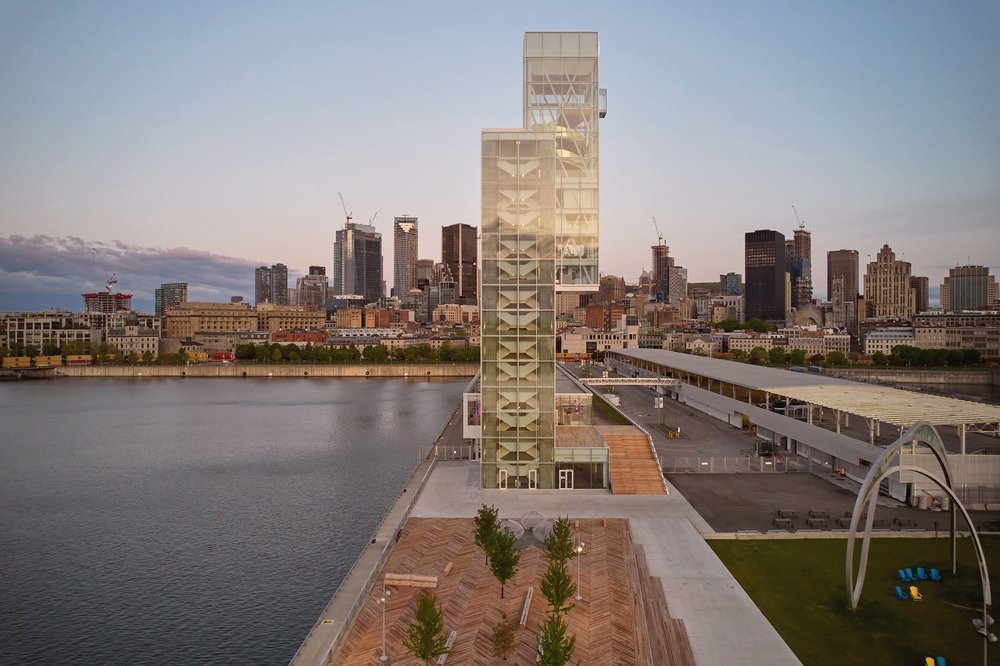This case study delves into the heart of the PSG Convention Hall, focusing on its crowning glory — the majestic roof. From the grand banquet hall beneath the ground to the soaring ellipsoidal dome, each architectural detail has a story to tell.
The multi-purpose PSG Convention Hall, located within the PSG Institute of Technology complex at Neelambur and conveniently situated near NH-544 at the entry point to Coimbatore city, offers a unique blend of architectural intrigue and elegant functionality. Designed to host diverse educational events for both PSG institutions and the public, the hall’s captivating skeleton exterior is a fitting prelude to the refined beauty within.
Architectural details
The convention centre unfolds across distinct levels, each serving a unique purpose. Beneath the ground lies the basement floor, home to the grand banquet hall within its reinforced concrete frame. Stepping up to the ground floor deck, is a contemporary 1500-seat auditorium. Below the elevated walkway, versatile conference halls offer additional meeting space. Ascending further, the floating upper gallery, an airy space 12 m wide and 36 m long, comfortably seats 300. Finally, the ellipsoidal roof, soaring to a height of 17 m, crowns the structure with its stunning silhouette, both inside and out.
Advanced composite aluminium panels seamlessly adapt to the dome’s complex geometry, showcasing both beauty and engineering prowess. A truncated geodesic dome, clad in glass panels and positioned strategically at the dome’s base, floods the inner walkways with daylight, further enhancing the structure’s sophistication. Elevating the ambience, the internal wall panelling combines sophistication with soundproofing, temperature control, and a soft glow.
Framing of roof
A majestic elliptical dome, stretching 90 m x 68 m, shelters a vibrant theatre core (36 m x 68 m) beneath its 17.1 m peak. A network of steel arches, both longitudinal and transverse, spaced precisely 6 m apart, springs from the base pedestals, forming the elegant framework. Intermediate concrete columns provide additional support along the inner ellipse.
Analysis and design
The originally conceptualised quasi-elliptical dome form had been converted to mathematical form for analysis and buildability. For the severe load combinations cited in
IS 800-07, the structure was analysed and designed with STAAD.Pro. The steel fabrication modelling has been provided by Tekla.
To translate the architect’s vision of a striking quasi-elliptical dome into a structurally sound reality, the power of digital tools using AutoCAD 3D and Rivet. They transformed the dome’s graceful curves into precise mathematical models, ensuring its feasibility and constructability.
To ensure the dome could withstand the forces of nature, a comprehensive structural analysis was done with STAAD.Pro software for stringent load combinations specified in IS 800-07. Tekla Structures provided a detailed 3D model of the steel elements, guiding the fabrication process with accuracy and efficiency. This model served as a digital blueprint, ensuring seamless coordination between design and construction.
The primary meridian arches of a clear internal span of 36 m, spaced at 6 m intervals, were designed at plate girders of depth 600 mm with flange plates of 300 mm x 12 mm. Secondary rafters connecting the base of the dome to its internal columns are steel box girders 300 mm deep. These vital intermediaries transmit horizontal reactions from the base of the column to the ground.


Purlins
Evenly spaced (1.5m apart) circular hollow section purlins, each 200 mm in diameter provide unwavering support for the roof cladding. These purlins offer exceptional torsional resistance, crucial for accommodating the variations in the roof’s profile. Additionally, their convenient shape allows for the attachment of the roof sheets, streamlining the construction process.
Gallery
Creating a comfortable 300-person seating area on a 12 m x 36 m upper deck posed a unique challenge with the absence of base columns. Two options emerged: a bold cantilever 12 m span or a more conventional 36 m beam supporting a concrete slab.
The cantilever, though interesting, was grounded by reality. Securing the necessary anchorage proved impossible, forcing a pivot towards the beam solution. The vast span demanded a composite girder of steel and concrete.
The steel box girders, each an immense 2.4 m deep and 1.8 m wide, stretch 36 m across the void. These beams of steel, each weighing 27 tonnes, form the mainstay of the structure. They support a network of cross girders spaced 3 m apart, spanning 12 m across with deck seat laid concrete.


And here’s the fascinating part: Had this beam been crafted of prestressed concrete, its weight would have swollen to a staggering 200 tonnes! The light steel frame retains incredible strength and offers an advantage in construction speed and flexibility.
Roofing sheet
The composite doubly curved standing seam metal roof system made up of two layers of metal sheets. The bottom layer is a Zn-Al-coated steel sheet that rests on top of the CHS purlins. A vapour control membrane is then stretched and secured to these metal sheets. Over this base, light gauge hat section purlins are laid. Metal standing seam clips are secured over the hat sections at 1 m intervals. Rigid glass wool insulation boards are placed between these clips.
The top layer of aluminium sheets are computer controlled on-site roll formed to create three-dimensional flowing shapes. These shapes are then combined with the standing seam system, where the sheets are folded and attached to the purlins with standing seam clips. The concealed press system requires no piercing for fasteners, which helps to make the roof watertight.
Facade glazing
Embracing the truncated geodesic dome’s geometry, its lower edge is adorned with a captivating glass facade. Curving upward in a sway of varying heights, each panel takes the form of an equilateral triangle measuring one meter each side. Set within sleek triangular aluminium frames, these double-glazed panels weave together, transforming the dome into an interplay of arches, purlins, and shimmering glass.
Nature-inspired acoustics and lighting
The hall’s sleek, curved wooden walls and roof panels serve a dual purpose: enhancing acoustics and echoing the sculpted beauty of the exterior. Additional wooden wall panels and a thick, insulated roof ensure tranquility within. For gentle illumination, diffused light dances across walls and surfaces, minimising glare and creating a serene ambience.
Quantum of work
The massive work covering a total built-up area of 1,00,000 sq ft consumed around 5000 m3 of reinforced concrete, 520 tonnes of reinforcement steel and 320 tonnes of structural steel.
Fact File
Project: PSG Convention Hall, Coimbatore
Client: PSG Institutions, Coimbatore
Architect: SD Sharma & Associates
Civil Contractor: Niketa Constructions
Structural Engineer: Mithran Structures
Fabricator: Armour Steel Buildings







